
 |
The Church at Alastaro, northwest of Loimaa. |
 |
The Church at Askainen, about 40 km northwest of Turku. |
 |
The Church at Eurajoki. |
 |
The Church at Dragsfjärd, dating from 1772. |
 |
The Church near the manor house, at Fagervik Iron Works. |
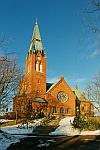 |
The Church at Forsaa. |
 |
The Church at Halliko. |
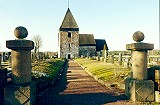 |
St. Catherines Church at Hammarlund, Aland Islands. Built sometime in the 12th century. |
 |
The Lutheran Church in the fortress city of Hammina, built in neoclassical style. |
 |
The church at Hanko, originally built of red brick and completed
in 1892. Severely damaged by the Russians during World War II,
it was restored in 1953. Click here to see other pictures of Lutheran Church of Hanko. |
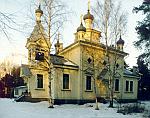 |
The Russian Orthodox Church in the port city of Hanko. The church was built in 1895 by the Russian merchants living in Hanko |
 |
The Evangelical Lutheran Church of Finland and the (Russian) Othrodox Church are the state churches of Finland. The book Facts About Finland indicates that 90% of Finns belong to the Lutheran Church, and another 3% to registered or unregistered denominations, and 60,000 belong to theOrthodox Church. There are Roman Catholic, Finnish Free Church, Adventist, Methodist and Jewish churches in the country, as well as small denominations such as this Jehovah Witness church in the port city of Hanko. |
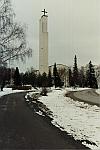 |
The modern church at Nakkila, located southeast of Pori. |
 |
The Church of the Holy Cross at Hattula, from the 1300's. Built
in the Gothic style of the South Baltic countries, it is the oldest
brick church in Finland, and one of the oldest brick buildings in Finland. Click here to see other pictures of the old church at Hattula. |
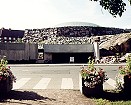 |
The entrance to Taivallahti or Temppeliaukio church, in Helsinki Also known as Rock Church, the church was built into solid rock and is one of Helsinki's foremost attractions. |
 |
St. John's Church in Helsinki, the largest church in the city. |
 |
The Church at Huittinen, dating from the 1340's. |
 |
The Church at Inkoo, dating from 1335. The church houses a unique painting called Danse Macabre. |
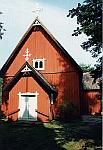 |
The Church at Irjanne, which is near the museum for that area. |
 |
The Church at Jokioinen, dating from the 1600's. Click here to see other pictures of the Lutheran Church of Jokioinen. |
 |
The Church of St. Olav at Kalanti, located about 8 km east of Uusikaupunki. The church was built before 1400 at a location were a wood church stood. Te mural paintings in the vestry date from about 1450. The bell tower was built in later half of the 15th century. The first wooden floor was installed in 1806. The church was last restored in 1965 - 68. |
 |
Kakskerta Church on an island south of Turku |
 |
The old church near Karkku, located 10 km northeast of Vammala, and about 35 km west of Tampere, |
 |
The church at Kerimäki in eastern Finland. The church, built in 1847 to seat 3300 people, is the largest wooden church in the world. |
 |
The church at Kimito on the Dragsfjärd peninsula. |
 |
The church at Kirkonkyla, located 7 km south of Aura, and northeast of Turku.. |
 |
Entrance to St. Michaels Church at Korpio, originating in 1384. The church, with its defensive
tower, is like the churches in Aland and other medieval churches of southwest Finland. Click here to see pictures of the interior of the church. |
 |
The church at Koski. There are 21 or more villages by then name of Koski in Finland. This village of Koski is located about 30 km north of Salo, and about 45 km northeast of Turku. |
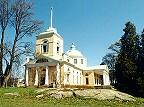 |
St. Nicholas Orthodox Church at Kotka, from 1795. The interior was designed by a French artist, who was a POW at the time. The church was part of a Russian fortress destroyed by the British during the Crimean War in 1855, only the church survived. A crystal chandelier in the church was a present of Empress Katherine in 1796. |
 |
The church at Kuusjoki, taken on a cold Sunday morning. Note how the bell tower doors have been opened for bell ringing prior to the church service. Kuusjoki is located about 15 kilometers north of Salo. |
 |
The church at Kuusisto near Pargas. |
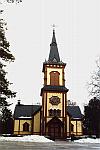 |
The church at Koylio, east of Aura. |
 |
The church at Lemu, located about 15 km northwest of Raisio. |
 |
The Lutheran church at Lappenranta, a wooden cruciform church dating from 1794. |
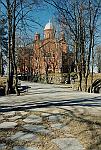 |
The Russian Orthodox church at Lappenranta, built inside the old Russian fortress in that city. It is the oldest Russian Orthodox church in Finland, built by Russian soldiers in 1785. |
 |
The cathedral at Loimann-kunta, one of German architect C. L. Engel's designs, built in 1837 |
 |
St. Martin's church at Marttila, dating from 1765, which is located northwest of Salo about 30 km. |
 |
The rural church near the village of Mellila, located about 10 km southwest of Loimaa, and about 45 km north of Salo. |
 |
The church at Merimasku. |
 |
The church at Metsamaa. |
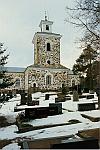 |
The church at Nummi, from 1819. The church is located about 45 km east of Salo. |
 |
The church at the small village of Merimasku, located west of Raisio about 16 km, and about 20 km west of Turku. |
 |
The church at Naantali. The town grew around a Catholic convent which was founded in 1443. The church was completed in 1462 and the tower in 1797. |
 |
St. Henry's Church at Nousianen. Bishop Henry, who established the first Finnish diocese here, was killed near here in 1156. The church was first mentioned in 1232. The church architecture is noted by the abundant use of bricks. The church contains a dark limestone sarcophagus, made between 1415 and 1420, which stands somewhere near the grave of Bishop Henry, who was killed nearby in 1156. The bell tower was built in 1759-60. |
 |
The veterans section of the cemetery at St. Henry's Church at Nousianen Most cemeteries in Finland have a section for veterans of WW II. A large percent of Finnish men lost their lives in WW II, defending their country against invasions by the German and Russian Armies. |
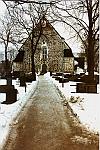 |
The 14th century church at Pargas, about 20 km south of Turku. The walls to the church date to the early 1300's. The wooden floor and benches were made in the 17th century. The pulpit is a copy of a work from 1647, the original is in the National Museum. The altarpiece dates to 1666, and the chandelier from 1746. |
 |
The church of St. Lawrence at Pernio, founded in 1480. It was preceeded by a wooden church at the same location. The murals on the vaults were completed around 1480. Their floral motifs are interpreted as symbolizing the Garden of Eden. Paintings also depict important Fathers of the Church, evangelists and Catholic saints. Some of the original wooden sculptures in the church remain, and date from the early 14th century. The altarpiece was painted in 1703. |
 |
The church at Pertilli, near Salo. |
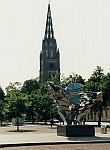 |
The Pori central church, built in neogothic style in 1863. A modern sculpture is in the foreground. |
 |
The church at Porvoo, from the 1400's. This building is where the first parliament in Finland assembled in 1809, after Finland became an autonomous part of Czarist Russia. |
 |
The Church of the Holy Cross in Rauma. Originally part of a Franciscan
Monastery, the church dates from the 1400's Rauma-founded in 1442,
is one of the great old cities in Finland. Click here to see other pictures of the Church of the Holy Cross at Rauma. |
 |
The church of Raisio, dating from 1305 |
 |
St. Jacobs Church at Renko, the only octagonal stone church in Finland, built in the late 15th century. |
 |
The
Church at Reposaari, built by Norwegian sailors, folowing a Norwegian design. Click here to see pictures of the interior of the church. |
 |
The church of Rymättylä, located about 15 km south of Naantali, and about 20 km west of Turku. |
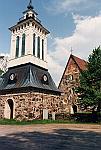 |
The church
at Sääksmaki, located about 32 km northwest of Hämeenlinna.
The church dates from the 15th century, and was restored in 1932. Click here to see other pictures of the church at Sääksmaki. |
 |
The moon rises over Uskela Church at Salo The church was designed
by the renowned architect C. L. Engel. The Uskela parish dates
from the 13th century. The church hill of Uskela has had a church
located there since 1440 Click here to see other pictures of the Uskela Church at Salo. |
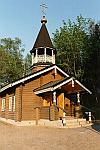 |
The Russian Orthodox church at Salo. |
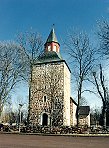 |
St. Mary's Church at Saltvik, Aland Islands. This is the principal church in Aland, the first part of this building was started in 1280 The location of this church is at a meeting place dating back to the Vikings. My wife's gr-gr-gr-gr-grandfather C.G. Kock, a prominent building contractor from 1830 - 1850, is buried in the church yard. |
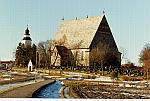 |
The church at Sauvo, between Salo and Pargas |
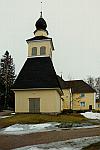 |
The church at Snappertuna, dating from 1688. |
 |
St. John's Church at Sund, Aland Islands. Built sometime after the church at Saltvik by the apprentice of that master builder Archbishop Wenni of the Catholic Church in Germany was buried here in 936. The mighty defense tower, used to defend against enemies of the church, has walls two meters thick. |
 |
The church at Tammela. |
 |
The church at Tammisaari, dating from 1650. |
 |
The church at Tarvasjoki, dating from 1779. The church is located about 30 km northeast of Turku. |
 |
The church at the Teijo Manor. This is the smallest stone church in Finland. |
 |
The steeple of the Turku Cathedral, the national shrine of the Evangelical Lutheran Church of Finland. Its oldest parts date back to the 13th century. Important people, including Catherine Mansdotter, Queen of Sweden and Finland are buried at the cathedral. |
 |
St. Olaf's church at Vammala, built in the late 14th century, with an interior which dates from the 18th century. |
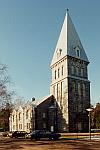 |
The church at Västanfjärd, on the Dragsfjärd peninsula. |
 |
The church on Velkua Island, about 20 km west of Naantali. The island is about 2 km square, and is connected to the mainland by a 2 km ferry ride. |
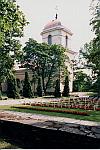 |
Construction of the church at Vihti began in 1770, after 10 years had been spent making bricks for the church. The church was finished in 1772. The church was destroyed by fire from lightning in 1818 and 1846, and repairs were finished in 1821 and again in 1848. The altar piece was painted in St. Petersburg in 1846 |
 |
The church at Yliskylä, near Pernio, founded in 1756. The cemetery surrounding the church is from the Iron Age. |
 |
The church at Ypäjä, located 10 km southeast of Loimaa, and north of Salo about 50 kilometers. |
Return to the Main Page